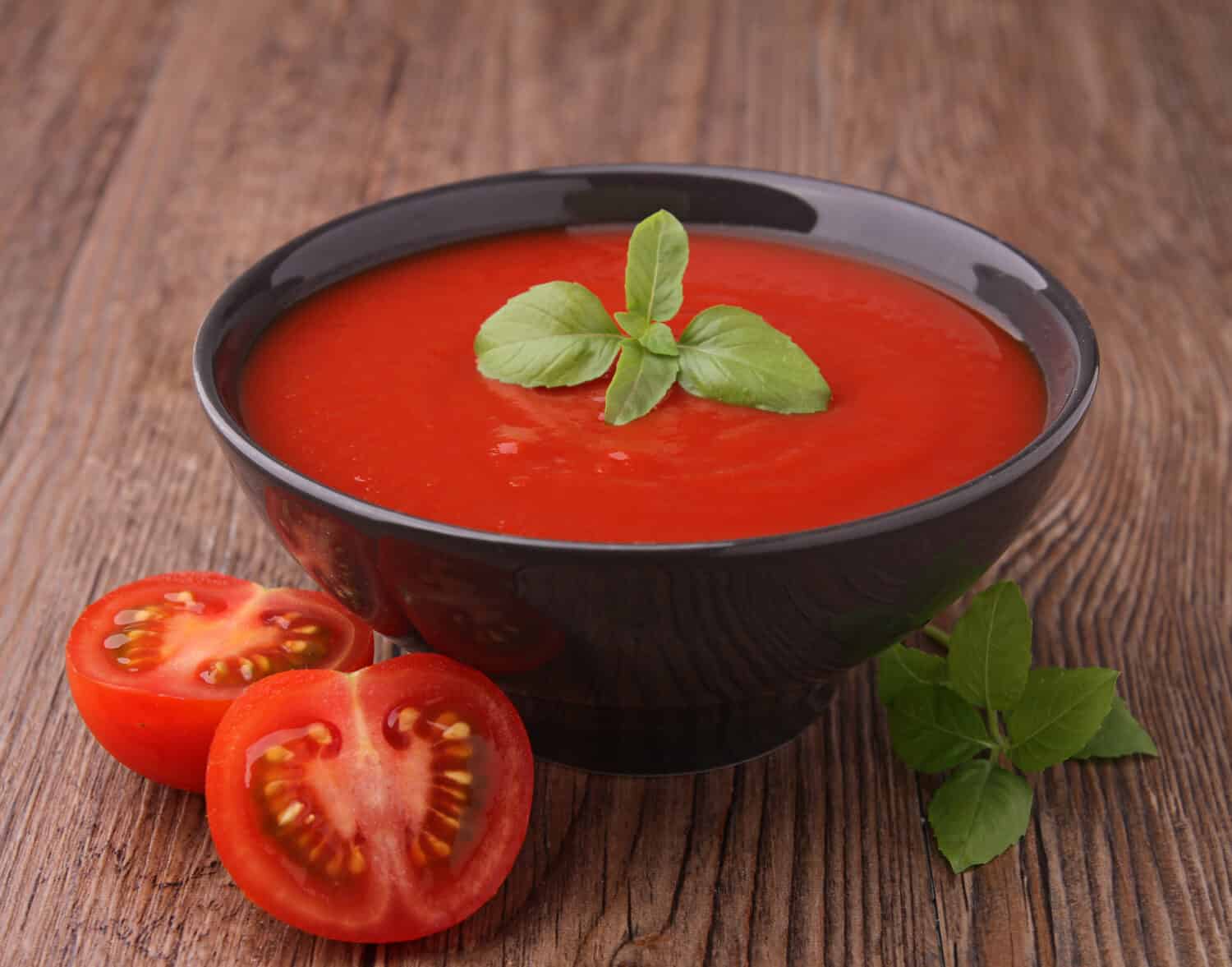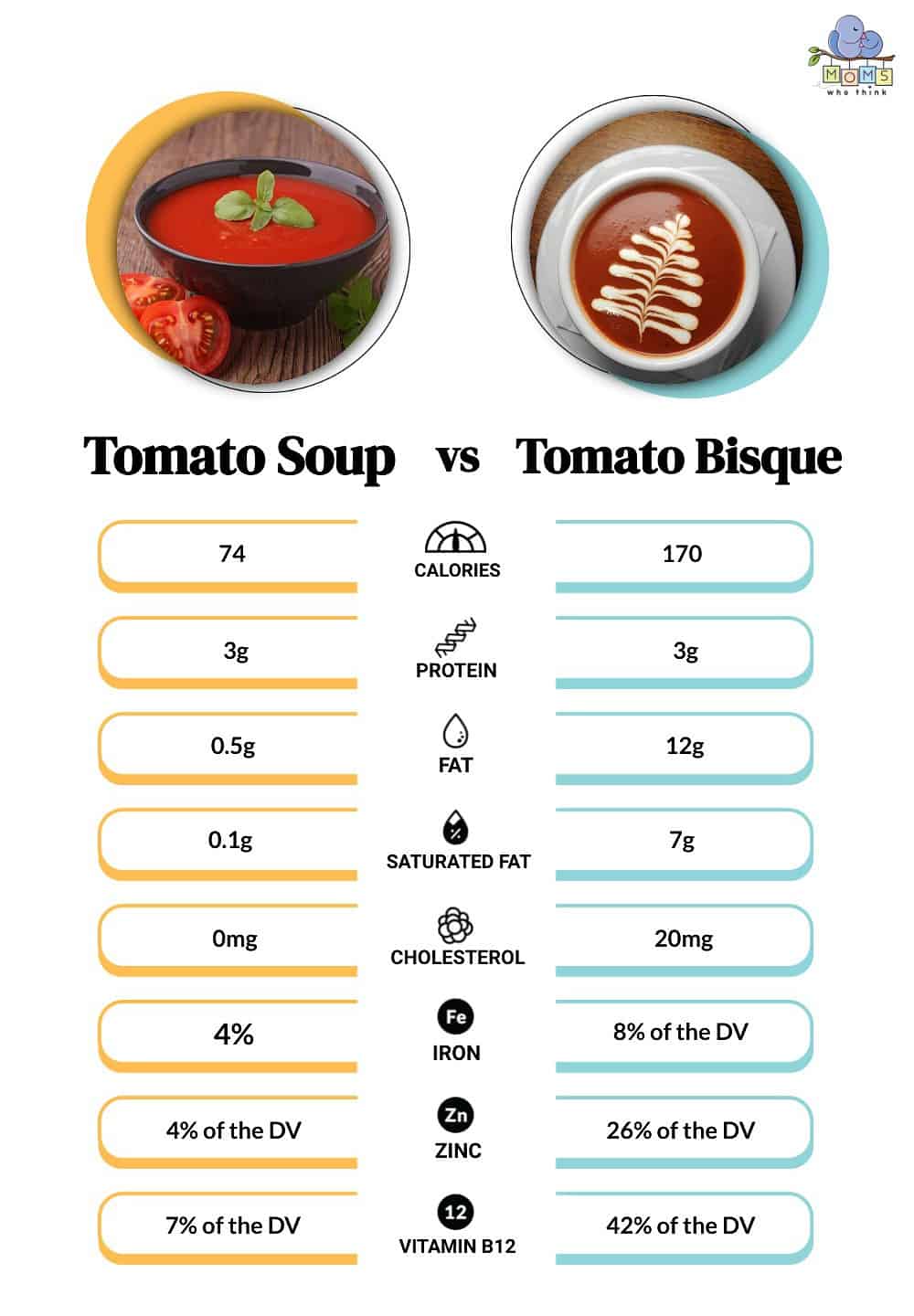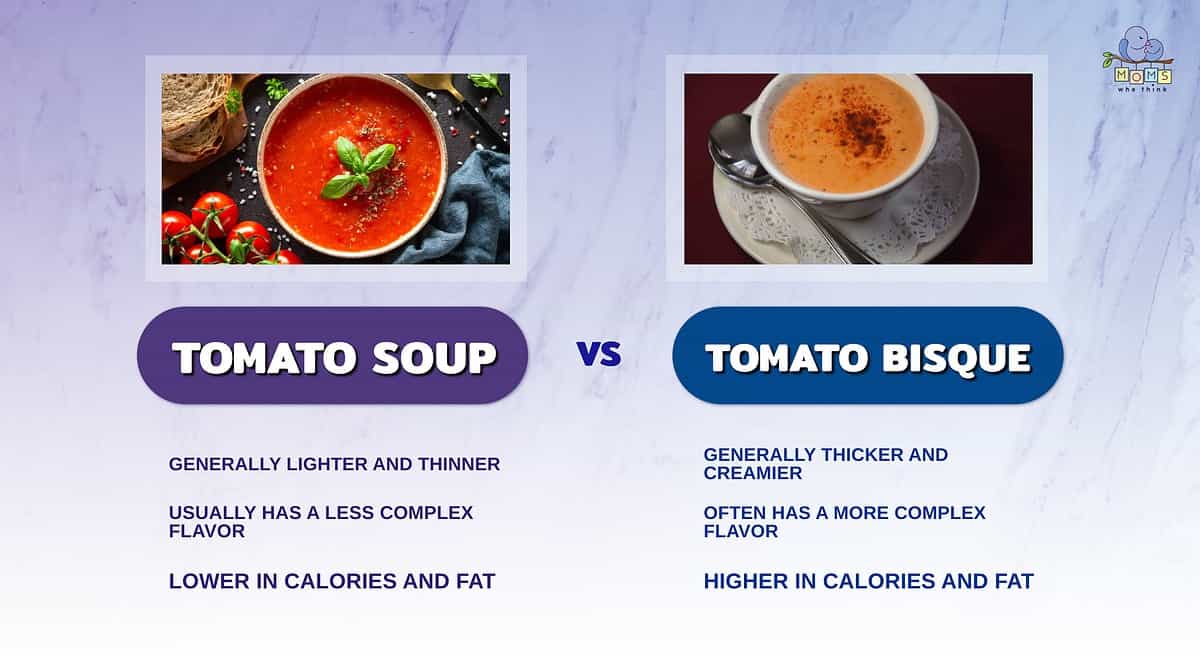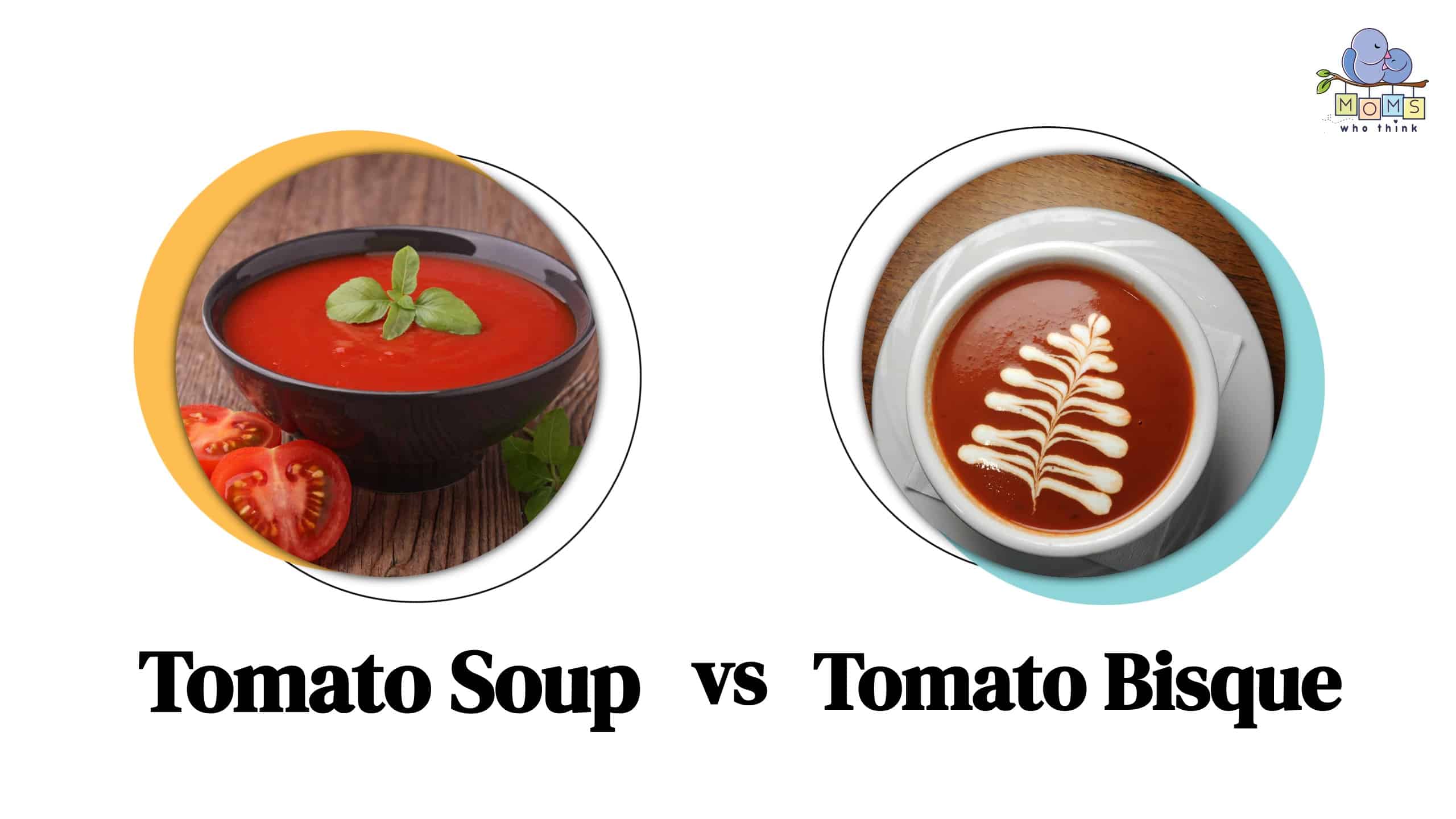Tomato soup is one of the most popular and versatile soups in the world. It's a soup that's used everywhere from school cafeterias to high-end restaurants. Yet, you've likely also seen tomato bisques on menus and wondered just what the difference between tomato soup vs tomato bisque is.
Let's dive into the differences between tomato soup and tomato bisque including nutrition and the history of where these soups originated from.

Tomato soup is a delicious and wholesome meal the whole family can enjoy.
©Chatham172/Shutterstock.com
Tomato Soup vs. Bisque: What Is the Difference?
The main difference between tomato soup and tomato bisque is that tomato bisque includes heavy cream or other thickening agents. Tomato bisque is generally heavier, incorporates more flavors, is often cooked with seafood, and has more calories per serving. Beyond the addition of cream, the two meals have fundamental differences in their variety and origins.
When creating a delicious and hearty tomato soup or tomato bisque, it usually involves combining tomatoes, sometimes with chicken or vegetable stock and extra liquid. These are the basic ingredients for making any tomato soup or tomato bisque.
Whether served hot or cold, you can always add your favorite side dish. Rich and cheesy sides taste perfect with tomato soup or tomato bisque and draw out the best flavors.
Tomato soup is widely accepted as a liquid dish, though it is actually less processed and more chunky in many regions. Typically, the soup isn't pureed and contains more significant bits of meat and vegetables such as carrots, parsley root, celery root, etc.
Tomato soup is a soothing classic for a reason. It can be luscious, creamy, comforting, hearty, or even zesty, fun, and rich.
That familiar scent you love can fill your mind with a mouth-watering feeling before you even take that first bite. Tomato soup can take anywhere from 15 min – 30 min to make.
Where Did Tomato Soup Originate?
Tomato soup originated in Andalucía in southern Spain. Interestingly enough, tomatoes belong to the same plant family as Atropa belladonna, also known as ‘Deadly Night Shade'. They were first thought to be poisonous until disproved in the 19th Century. In 1897, Joseph Campbell and Dr. John T. Dorrance theorized and then invented a method for condensing soups and storing them in a can ready to open and eat.
One of the company's first canned soup flavors was Beefsteak, closely followed by Tomato Soup, which soon became the company's flagship product for many years.
Canned foods and soups became an entirely new industry of food production and preservation techniques, and it was generally simple to efficiently manufacture, store, and transport.
Canned soups and foods were easier to supply and distribute to soldiers during times of war, especially on the frontline. The canned soup would last longer, ensuring soldiers were well-fed and nutritionally supplied.
A hearty tomato soup warming the tummy on a cold night is still a loved addition to any kitchen table.
Where Did Tomato Bisque Originate?
In comparison, bisque is of French origin. Tomato bisque is especially a thicker, silkier, and creamier version of its Spanish soup counterpart.
Initially, the bisque was prepared using shellfish and seafood. The shells from the seafood, such as shrimp, clam, or lobster, never went to waste. Being crushed into a fine paste and further reduced, then finally becoming the main thickening agent.
Tomatoes, chicken or vegetable stock, and a thickening cream were later added as common ingredients. Compared to tomato soup, tomato bisque takes longer to prepare, taking anywhere from 20 min – 1 hr and 10 min to complete.
Note: If you are ordering tomato bisque in a restaurant, you should ask if they have used seafood bisque in case you have any seafood allergies.

Tomato bisque is a creamier alternative to tomato soup – but it's equally as tasty.
©Toasted Pictures/Shutterstock.com
Can You Substitute Tomato Soup for Tomato Bisque?
Although both would taste substantially better with fresh tomatoes or canned tomatoes, you can substitute fresh or canned tomatoes with tomato sauce, French onion soup, corn soup, or tomato paste in many recipes.
Here are five tomato variations you could try when substituting tomato soup for tomato bisque.
Tomato Sauce
Tomato sauce is a beautiful substitute for tomatoes as they have a credible tomato taste and contain no dairy products.
Nomato Sauce
Nomato sauce is also used as a great substitute in any recipe. It is produced using a variety of root vegetables and flavors, contains no soy, dairy, wheat, gluten, nuts, or tomatoes, and is naturally rich in antioxidants and nutrients. However, nomato sauce is often more expensive than other tomato substitutes, so most people find cheaper alternatives that work better for them.
Tomato Paste
Tomato paste is a beautiful substitute for cream as it has a creamy and rich tomato taste without incorporating any dairy. This is a beneficial alternative for those allergic to dairy or are lactose intolerant.
It can also be used instead of tomatoes as it is typically cheaper than canned or fresh tomatoes. The consistency differs between brands, so you might have to thin it out with extra fluid, such as water, almond milk, vegetable stock, etc.
French Onion Soup
French onion soup is a hot, delicious soup prepared with caramelized onions. It's typically served in bread bowls or cups and topped with cheddar cheese.
Corn Soup
Corn soup is a thick and smooth soup seasoned with corn, spices, flavors, vegetables, and sometimes cheddar.
Do Tomato Soup and Tomato Bisque have the same nutritional values?

Tomato soup is lower in calories and fat.
©
Nutrition Facts (per serving)
| Nutrition | Tomato Soup | Tomato Bisque |
|---|---|---|
| Calories | 74 | 170 |
| Fat | .5g | 12g |
| Carbs | 9g | 23g |
| Sugar | 4g | 4g |
| Protein | 3g | 3g |
As you can see, tomato bisque has more calories than tomato soup. The difference in calories will depend on how much cream is used in bisques. More added cream will also result in a much higher percentage of calories from fat macronutrients as well.
In Conclusion

- If you're looking for a hearty and filling meal, tomato bisque is definitely the way to go. Tomato soup is best for a light lunch or dinner.
- Tomato bisque often has more flavors added to it, giving it a more complex flavor profile. It can even have seafood added to it!
- Tomato soup has less fat and fewer calories than tomato bisque, making it ideal for those on a diet.
Despite sharing some similarities, both tomato soup and tomato bisque differ in appearance, ingredients, and cooking methods. Even though tomato soup can be made with various ingredients, bisque is classified by its smooth, silky texture and is frequently cooked with seafood. Understanding these variations will enable you to choose the perfect dish for any celebration, whether you're looking for a rich bisque or a hearty soup.
Tomato Soup and Tomato Bisque Recipes
Print
Easy Tomato Soup
Ingredients
- 4 cups chopped fresh tomatoes
- 2 cups chicken broth
- 1 onion sliced
- 2 tablespoons butter
- 4 cloves garlic
- 2 tablespoons all-purpose flour
- 1 teaspoon salt
- 2 teaspoons white sugar, or to taste
Instructions
- Gather all the ingredients.
Combine the tomatoes, slices of onion, a few garlic cloves, and chicken broth in a stockpot over moderate heat. To mix the flavors, bring it to a gentle boil and cook for 20 minutes.
Remove it from the heat and pour the mixture into a big bowl or pan after passing it through a blender or food processor.
Melt the butter in the now-empty stockpot over medium heat. Make a roux by stirring in the flour and heating it until it reaches a medium brown color.
Stir in the remaining tomato mixture after gradually whisking in small amounts to prevent lumps. Add salt and sugar, and season to taste.
Serve hot or cold with your desired bread or croutons.
- Storing tomato soup: Refrigerate your homemade tomato soup in an airtight container. The soup will keep in the refrigerator for 3 – 4 days, or you can freeze tomato soup for up to 6 months.
Easy Tips When Cooking Tomato Soup and Tomato Bisque
A large pot (sometimes called a Dutch oven) with a wide, heavy bottom is best for preparing soup or bisque. Furthermore, ensure your soup boils evenly and doesn't burn on the bottom; it is preferential that your pot is either stainless steel or enameled cast iron.
Store your tomato brisque in an airtight container for up to 3 to 4 days in the fridge.


